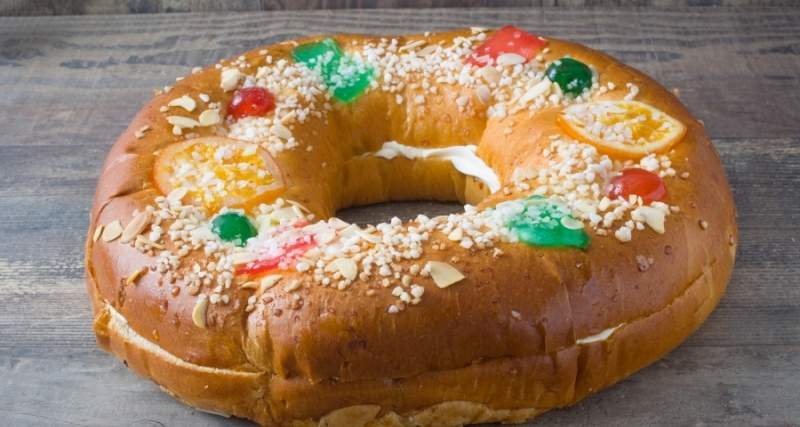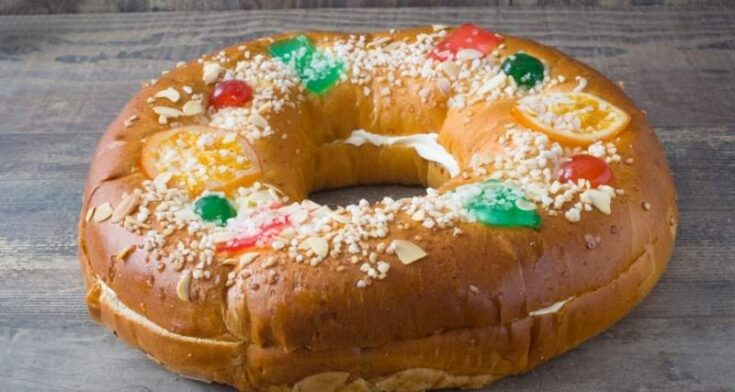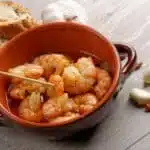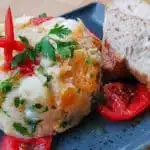Are you familiar with Spanish Three Kings Cake? Get to know more about the rich tradition surrounding this dessert and try your hand with our Roscon de Reyes recipe at the end of the article.
Three Kings Cake is a type of round or oval cake decorated with all sorts of candied fruits, chopped nuts, and sugar and filled with delicious fillings such as cream cheese and praline cream.
Read also: Traditional Spanish Desserts + Spanish Dessert Recipes
Where Did The Kings Cake Come From?
Three Kings Cake is believed to have come from France. This version of the cake’s creation story is rooted in Christianity, with the name “three kings” pertaining to the Three Magi from the Bible who have come to visit the Child Jesus.
There is a story that talks about King Louis XV of France being served by his chef a traditional roscon bearing a surprise inside in celebration of the Feast of the Epiphany or Three Kings’ Day. The surprise was a diamond medallion baked inside for the King to find.
King Louis XV might have loved the idea so much because he promoted the Three Kings Cake within the French and European aristocracy. As Christianity spread all over the world, so did the tradition of serving the Three Kings Cake.
It was during the 18th century when the cake finally arrived in Spain. The Spanish Three Kings Cake will later be called Roscon de Reyes in the native language.
Some stories, though, say that way before the Three Kings Cake was tied to the Epiphany, ancient Romans were already preparing something similar. A round cake adorned with figs, honey, and dates was being served during the winter solstice festival known as Saturnalia.

When do Spaniards eat the Roscón de Reyes?
People from Spain serve Roscón de Reyes during the holiday season. It is eaten especially during breakfast on January 6th in celebration of the Three Kings. Bakeshops sell Spanish Three Kings Cake with a crown included.
This is for the person who gets the surprise inside – usually, a tiny plastic baby that (arguably) symbolizes the infant Jesus.
Whoever gets the slice with the small figure gets to be the king for a day. By tradition, they will also be the host and the one in charge of bringing the Roscón de Reyes the following year.
Tips on Making Roscon de Reyes
- Get creative with your filling! While there is always the dependable cream, you can also go for bold ones like praline.
- How do you hide the baby figurine inside the Three Kings Cake? You can place the trinket on the dough just before baking as long as you’re sure it won’t melt from the heat. You can also just choose to poke it in from below, right after the cake gets baked.
- If you do not have a baby figurine available, you can choose from any of these “surprises” which are also utilized by bakers for the same purpose: fava beans, crowns, rings and gold coins.
- If you are not sure which warm place to put your dough in for resting, you can preheat your oven to 50 degrees Centigrade, and when it is time to rest your dough, you can turn the heat off and place the bowl or tray of dough inside.
Ingredients for Roscon de Reyes
- 5 1/4 cups (650 grams) of strong flour
- 1 cup (250 mililiters) of warm milk
- 2 tablespoons + 1 teaspoon (25-30 grams) fresh yeast
- 5/8 cups (120 grams) sugar
- 1/2 cup (120 grams) melted butter
- 2 eggs and 1 egg yolk
- 1.7 teaspoons (10 grams) salt
- 2 and 1/2 tablespoons orange blossom water
- Grated peel of 1 large lemon and 1 orange
For the decoration:
- Candied fruit to taste
- Sugar
- 1 beaten egg
- One orange
- Bakeable figures

Spanish Three Kings Cake Recipe – Step-by-step instructions
1. Prepare your starter dough: In a bowl, mix a bit of the warm milk with about three tablespoons of flour. Add in all the fresh yeast and stir properly until everything is dissolved. Cover the bowl with a lid. Place it in a warm place and allow the dough to ferment for about 20 minutes.
2. In another bowl, combine your wet ingredients: lightly beat your eggs and add in the rest of the milk, followed by the melted butter and orange blossom water. Mix in the lemon and orange zest.
3. Take a large bowl and combine the sugar, salt, and the remaining flour. Add in the fermented starter dough. Little by little, add the mixture of the wet ingredients. Mix until the dough becomes homogeneous.
4. Find a smooth surface to knead your dough. Spread some flour over the surface, transfer your dough and start kneading. Add in some flour as you go. You know you’re done when your kneaded dough is shiny, smooth, and elastic. Once you have achieved this, shape your dough into a big ball. Transfer it to a lightly greased bowl, cover with a damp cloth, and let it rest in a warm place.
5. Wait for at least two hours or until the dough has risen two times its original size. Knock the dough back on a smooth floured surface and start kneading again.
Transfer it on a lined baking tray and begin forming the round or oval shape of the Roscon de Reyes, making sure to place a big hole in the center of the dough.
Once the cake bakes and rises in the oven, the hole will become smaller so it is important to start with a hole that is big enough. Return the shaped dough to a warm place, again covered with a damp towel, and allow it to rest for about one hour.
6. Preheat your oven to 360 degrees Fahrenheit (180 degrees Celsius). Use this time to crack one egg to brush on top of your roscon. Decorate it, for example, with candied fruits, powdered sugar, chopped nuts. If you like to keep it traditional, add the baby figurine or a trinket of your choice.
7. Bake the decorated roscon for 15 to 20 minutes, depending on the size. Afterward, let it cool down before cutting the cake in half horizontally and filling it with the flavor of our choice.
8. Enjoy your homemade Spanish Three Kings Cake!
Frequently Asked Questions
Why is it called Roscón de Reyes?
Spanish Three Kings cake is called Roscón de Reyes in the local language. “Roscón” is the sweet circular cake itself while the word “Reyes” translates to “kings” in English.
What happens if you get the baby in the King Cake?
If you get the small baby figurine from your slice of roscon de Reyes, you get declared to be king for the day! Aside from that, as per tradition, you are the host of next year’s celebration – and that makes you in charge of preparing the Three Kings Cake!
What does a king cake taste like?
The roscon in a classic Roscón de Reyes recipe is sweet, with a form or texture that resembles a brioche. It is made fruity with the addition of candied fruits.
Roscón de Reyes Recipe (Spanish Three Kings Cake)

Ingredients
- 5 1/4 cups (650 grams) of strong flour
- 1 cup (250 mililiters) of warm milk
- 2 tablespoons + 1 teaspoon (25-30 grams) fresh yeast
- 5/8 cups (120 grams) sugar
- 1/2 cup (120 grams) melted butter
- 2 eggs and 1 egg yolk
- 1.7 teaspoons (10 grams) salt
- 2 and 1/2 tablespoons orange blossom water
- Grated peel of 1 large lemon and 1 orange
For the decoration
- Candied fruit to taste
- Sugar
- 1 beaten egg
- One orange
- Bakeable figures
Instructions
1. Prepare your starter dough: In a bowl, mix a bit of the warm milk with about three tablespoons of flour. Add in all the fresh yeast and stir properly until everything is dissolved. Cover the bowl with a lid. Place it in a warm place and allow the dough to ferment for about 20 minutes.
2. In another bowl, combine your wet ingredients: lightly beat your eggs and add in the rest of the milk, followed by the melted butter and orange blossom water. Mix in the lemon and orange zest.
3. Take a large bowl and combine the sugar, salt, and the remaining flour. Add in the fermented starter dough. Little by little, add the mixture of the wet ingredients. Mix until the dough becomes homogeneous.
4. Find a smooth surface to knead your dough. Spread some flour over the surface, transfer your dough and start kneading. Add in some flour as you go.
You know you’re done when your kneaded dough is shiny, smooth, and elastic. Once you have achieved this, shape your dough into a big ball. Transfer it to a lightly greased bowl, cover with a damp cloth, and let it rest in a warm place.
5. Wait for at least two hours or until the dough has risen two times its original size. Knock the dough back on a smooth floured surface and start kneading again.
Transfer it on a lined baking tray and begin forming the round or oval shape of the Roscon de Reyes, making sure to place a big hole in the center of the dough.
Once the cake bakes and rises in the oven, the hole will become smaller so it is important to start with a hole that is big enough. Return the shaped dough to a warm place, again covered with a damp towel, and allow it to rest for about one hour.
6. Preheat your oven to 360 degrees Fahrenheit (180 degrees Celsius). Use this time to crack one egg to brush on top of your roscon.
Decorate it, for example, with candied fruits, powdered sugar, chopped nuts. If you like to keep it traditional, add the baby figurine or a trinket of your choice.
7. Bake the decorated roscon for 15 to 20 minutes, depending on the size. Afterward, let it cool down before cutting the cake in half horizontally and filling it with the flavor of our choice.
8. Enjoy your homemade Spanish Three Kings Cake!
Nutrition Information:
Yield:
4Serving Size:
1Amount Per Serving: Calories: 760Total Fat: 9gSaturated Fat: 4gTrans Fat: 0gUnsaturated Fat: 5gCholesterol: 194mgSodium: 106mgCarbohydrates: 142gFiber: 7gSugar: 9gProtein: 26g
The nutritional information provided is approximate and can vary depending on several factors, so is not guaranteed to be accurate.


Leave a Reply